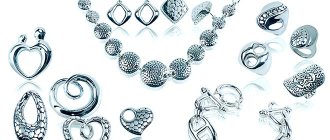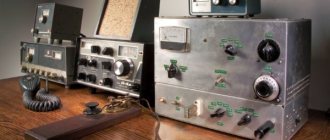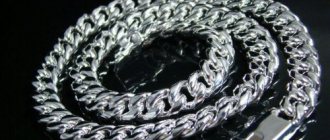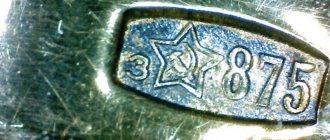Silver is the most common metal used to make jewelry and cutlery.
Few people know what the 84th hallmark on silver products means, so let’s try to understand this issue in more detail. Silver is one of the most common precious metals, from which jewelry, cutlery, souvenirs, dishes, and more are made. Few people know that some silver items may contain the 84th standard. What kind of sample this is and what it means, we will consider later in the article.
There is always some kind of mark on an 84-carat silver product. This is a master's mark, which means the product was made in pre-revolutionary Russia. In those days, a spool system was used to indicate the sample.
Composition and properties
The 84-karat alloy contains 87.5% silver, the rest is copper. The alloy may also contain:
- zinc;
- aluminum;
- nickel;
- cadmium.
Each additive affects the mechanical properties and color of the alloy.
Strength
Due to the copper content, products made from the alloy have high strength characteristics compared to pure silver. The products are not subject to mechanical wear, do not wear out, do not scratch or darken. Copper also gives the alloy a yellow tint.
What types of brands are there?
According to the rules of the assay system of Tsarist Russia, craftsmen had to apply marks to jewelry indicating the fineness of the jewelry metal. The first mark consisted of:
- precious metal sample numbers;
- female profile facing left;
- managers' initials.
To avoid counterfeits, the mark was changed in 1908: the female profile was turned in the opposite direction and letters were added to indicate the area of manufacture. Also in antique products you can find the mark of the master and the year of manufacture.
See photos with various marks:
Conversion from spool to metric system
To find out which modern standard 84 corresponds to, you need to convert the value to the metric system. To convert 84 samples, you need to divide it by 96 and multiply by 1000.
Thus: 84 / 96 * 1000 = 875. In the metric system, 1 kg of 875 silver contains 875 g of pure metal and 125 g of impurities (copper).
What standard is antique silver?
Zolotnikova. A beautiful word, but almost never used nowadays. Because the spool system was abolished in Russia in 1927. Now, a silver product with a spool hallmark can only be bought in an antique store and, accordingly, it is old and expensive.
You were given a teaspoon with a purity of 14, and your great-grandmother gave you almost the same one, but with a purity of 84? Consider yourself rich. Because in your hands are antique products made in Germany before 1888, with a lot hallmark, and in Russia, with a spool hallmark. And they correspond to today's 875 silver standard.

Antique spoon 84 standard
These numbers are quite easy to understand. They all talk about the mass of silver in the product, but only in different counting systems. Thus, the ancient Russian one was based on the pound, which was equal to 96 spools. In the current metric system, 96 spools are pure silver, over 0.999 in weight of the alloy. To convert the spool test to metric, you need to divide it by 96 and multiply by 1000.
That is, by dividing and multiplying the 84 spool sample of your silver spoon by the indicated numbers, we get 875 sample. You can also make calculations using the second spoon. But why? After all, transfers of samples from different systems for measuring the mass of silver were made long ago and the corresponding tables were compiled.
For example, you can use the one below. It contains basic data by which you can determine what standard the antique silver is:
| Accepted metric silver standard | 750 | 800 | 875 | 916 | 925 | 960 |
| Corresponding mass of silver in the alloy | 0,750 | 0,800 | 0,875 | 0,916 | 0,925 | 0,960 |
| The relationship between spool and metric samples | 77 (800) | 80 (830) | 84 (875) | 88 (925) | 92 (960) | 96 (999,9) |
| The ratio of lot and metric samples | 6 (375) | 8 (500) | 10 (625) | 12 (750) | 14 (875) | 16 (999,9) |
Of course, there are other sampling systems, for example, the old English troy system or the old Spanish one. But you can hardly find silver items made from them on the shelves of antique stores. In addition, there were more spool samples than in the table above. But due to the low composition of silver in the alloy, they were not of particular value and were quite rare. If necessary, you can use additional literature or the services of a specialist. And again to the silver spoon from my great-grandmother. Despite the fact that the spoon is 875 standard (not the highest), it is valued in antique circles much more expensive than modern products of the same standard.
| Metal sampling system: | |||
| Metal | Metric | Zolotnikovaya | Carat |
| Gold | 375 | 36 | 9 |
| Gold | 500 | 48 | 12 |
| Gold | 583 / 585 | 56 | 14 |
| Gold | 750 | 72 | 18 |
| Gold | 958 | 92 | 23 |
| Gold | 999 | 96 | 24 |
| Silver | 750 | 72 | 18 |
| Silver | 800 | — | — |
| Silver | 875 | 84 | 21 |
| Silver | 916 | 88 | 22 |
| Silver | 925 | — | — |
| Silver | 960 | — | — |
| Silver | 999 | 96 | 24 |
| Platinum | 950 | — | — |
| Palladium | 500 | — | 12 |
| Palladium | 850 | — | — |
Advantages and disadvantages
In its pure form, silver is a very beautiful metal, but it is soft, so products quickly lose their shine and are easily damaged. Therefore, with the help of additives (ligatures), the strength and wear resistance of products is increased. The peculiarity of this metal is its yellow color, which misleads ordinary citizens.
The 84th or modern 875 standard is considered low, and jewelry is not made from it. Due to the copper content, 84-grade silver is cheaper in price, but the presence of an alloy makes the metal stronger. Dishes made from it can be used in everyday life, washed and cleaned. Silver does not scratch and retains the brightness of the surface.
Use of silver
But in everyday life and everyday life, such products were used by Russians extremely rarely. Since their main function was to demonstrate the high financial position and social status of the owner. Their entire meaning and value in those days was based solely on the material costs that were incurred in the process of making the objects, and silverware was so expensive that its ownership raised the social status of the family and clearly demonstrated a high level of wealth.
By now, items from those times have increased in value even more. Since it now includes not only the price of directly used jewelry, but also the value of time.
It's no secret that since ancient times, silver has been considered a magical metal that can protect its owner from various ailments, so wearing silver accessories, according to some people, can help them attract good luck and have a beneficial effect on their well-being. Perhaps this cannot be called a very popular phenomenon, but some wealthy businessmen prefer to purchase not fashionable and stylish gadgets, but rather antique silver jewelry that came to us from pre-revolutionary Russia.
Based on the above, it becomes obvious why only very rare collectors do not want to receive such a treasure in their collections; they simply do not have enough funds. Therefore, if your friend is expecting some kind of special occasion, then why not consider some antique item made from 84 sterling silver as a gift from you.
For a woman, this could be some kind of antique jewelry - a ring or chain; a man will be happy with silver cufflinks or a cigarette case. A silver table set is suitable as a gift for a silver wedding anniversary.
How much does 1 gram of silver of this standard cost today?
The cost of valuable metals fluctuates depending on the situation on the world market. By tracking the daily reports of the Central Bank of Russia, you can find out the current cost. The price at a pawn shop or antique market may vary.
Below is a live graph and table with prices.
| Price 999 standard according to the Central Bank | Market value of the sample today | Scrap price | Price in jewelry |
St. George's Cross without number designation, made of 84 sterling silver
Description:
St. George's Cross (Insignia of the Order of the Holy Great Martyr George the Victorious) without degree. Established in 1913. Russian empire. Provisional government. Production output (manufacturing) 1914-1917. the private factory of Nikolai Druzhinin in the city of Yaroslavl or Nikolai Dubrovin in the city of Moscow. Original, original (cross and intermediate link). Copy (tape).
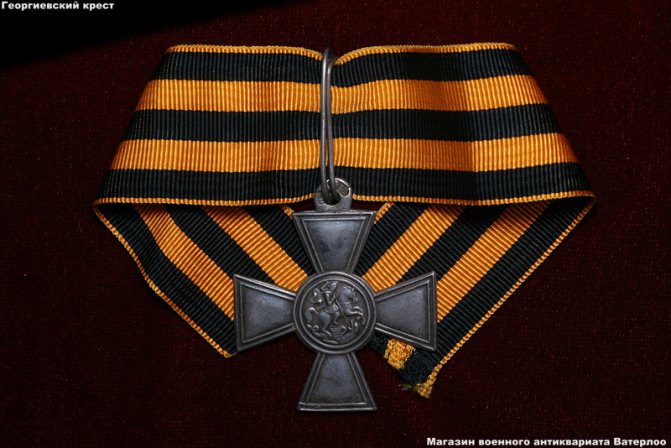
This presented St. George Cross was awarded to the lower ranks, privates and non-commissioned officers of the Russian Imperial Army and the Russian Imperial Navy of the Russian Empire for their heroism during the First World War (1914-1918).
In some cases, officers could also be awarded the Soldier's Cross of St. George, starting in 1917, by decision of the soldiers' committees (Resolution of the Provisional Government 10/4 of July 20, 1917, signed by Major General Yakubovich).
The St. George Cross without a number designation could be ordered from a private manufacturer in case of loss or during World War 1, a soldier could participate in a charity event to help the front, exchanging his silver cross in exchange for a brass one (exchanging precious metals for cheaper materials was a frequent practice of European states during 1 World War; in Germany it took place under the slogan “I will give gold for iron”).
Award status: obsolete: (not awarded).
Material and manufacturing technique: silver, casting, stamping, drawing, fabric, sewing.
Cross size excluding mounting eye: total 36 x 36 mm.
Condition: good collectible condition, patinated formations, minor nicks and scratches. No pad.
Description of the award: made in the shape of an equal-ended cross (a variant of the Patti Cross) with an eyelet, an intermediate ring and a ribbon.
Obverse: in the central medallion in a double contour circle there is an image of the Holy Great Martyr George the Victorious on a rearing horse striking an overturned serpent with a spear into the mouth. Production markings (stamps) on the ear of the cross: in oval circles there is an image of a head in a kokoshnik and Arabic numbers 84 (84 silver), letter abbreviations in Russian of the Cyrillic alphabet N.D. (full text; Nikolay Druzhinin, silverware workshop, Yaroslavl or Nikolay Dubrovin, silverware workshop, Moscow).
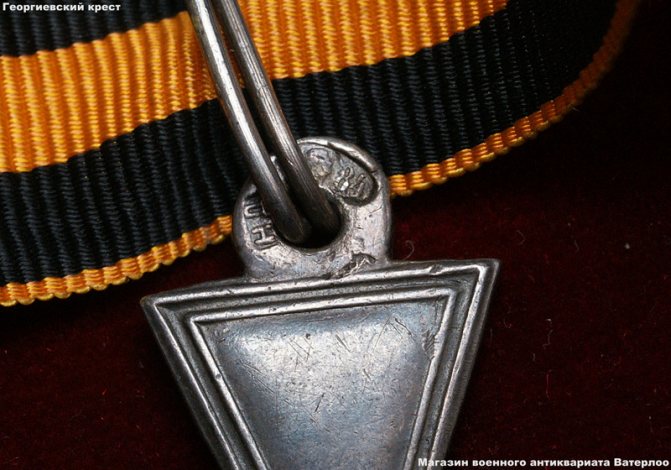
Reverse: in the central medallion there is an image of a monogram in the form of letter abbreviations in the Russian language of the Cyrillic alphabet (full text; SAINT GEORGE).
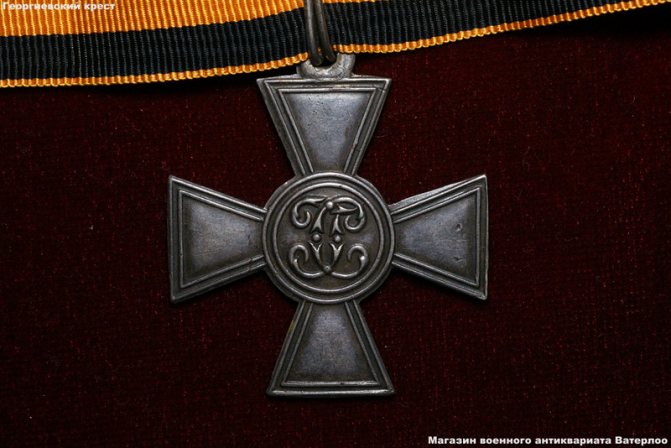
Ribbon: decorated with seven vertical stripes, orange and black (the colors of the Order of the Holy Great Martyr George the Victorious).
Prices for soldier's St. George crosses without a number designation made of silver, the Russian Empire and the Provisional Government, on the antique market in Russia range from 15,000 to 30,000 rubles, depending on the configuration (block, ribbon), private or state production, and of course the condition (preservation of the item).
It is better to purchase an award in specialized antique stores (preferably with an expert opinion) or from dealers with a good reputation!
Price: 31,000 rub.
Buy
Recommendations for care, cleaning and storage
Those who are lucky enough to become owners of antique cutlery should follow the rules for caring for them:
- wash with warm soapy water and air dry;
- store wrapped in soft cloth;
- Avoid rooms with high humidity.
If the product has darkened, you can clean it with a mixture of salt and soda. You should mix these two components, apply it to the item and wait until it takes on its original appearance.
Then rinse with water and wipe.
Reviews
Valentine
Thanks for the information, it turns out that antique items should be sold not by the gram, but as a whole. And the better the condition of the item, the greater the amount you can get.
Igor Ivanovich
I have an antique silver spoon from tsarist times, inherited. At first I wanted to sell it, but decided to use it on the farm. I think the food tastes better from it.
Zoya
In our pawnshop they accept silver so cheaply that it would be better worth it at home. I will donate it to museums as an antique, or pass it on to my grandchildren as an inheritance.


